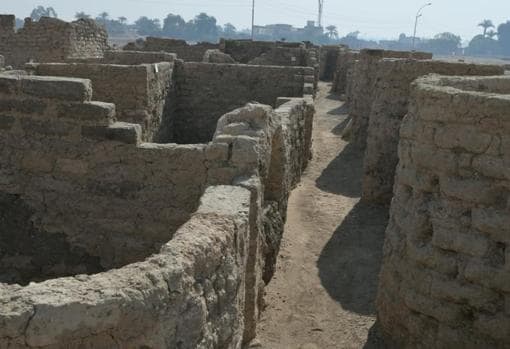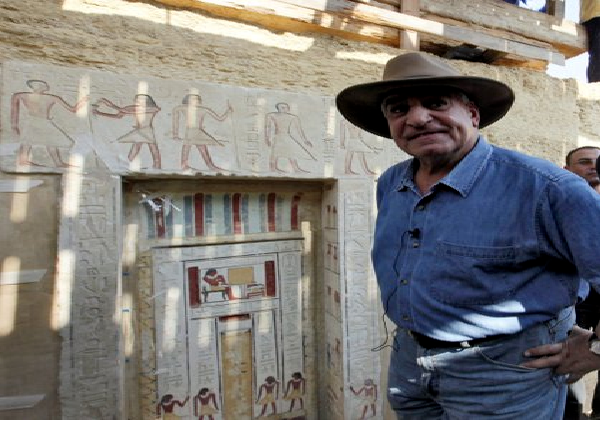They rate the discovery as the most important since the tomb of Tutankhamun.
April 08, 2021.- The history of this city dates back to the reign of Pharaoh Amenhotep III, an important king of the 18th dynasty who ruled Egypt between 1391 and 1353 BC. It remained active in the time of his son and future heir to the throne, Amenhotep IV, ‘Akhenaton’, with whom he shared the last eight years of his reign, as well as in the reign of his successors Tutankhamun and Ay. According to Hawass, it was the largest administrative and industrial settlement of the Egyptian Empire era on the west bank of Luxor.
“Many foreign missions searched for this city and never found it,” said former Egyptian Antiquities Minister Zahi Hawass when announcing that the Egyptian mission he leads has discovered a city lost under the sand in Luxor that received the name ‘ The Rise of Aton ‘.

A serendipitous find
The Egyptian mission that has discovered “the greatest city ever found in Egypt”, in Hawass’s words, began by searching for the mortuary temple of Tutankhamun in an area between the temple of Ramses III at Medinet Habu and the temple of Amenhotep III at Memnon. Nearby had been the temples of Horemheb and Ay.
Shortly after excavations began in September 2020, they were surprised by formations of adobe bricks in all directions. What they unearthed was a large city, in good condition, with almost complete walls and rooms full of everyday objects. According to the mission director, the archaeological layers have remained intact for thousands of years, as if the ancient residents had left them yesterday.
“The streets are flanked by houses, with stones in their walls up to three meters high”, describes the archaeologist before continuing by saying that “the city extends to the west, to the famous Deir El-Medina.”

In the opinion of Betsy Brian, professor of Egyptology at the American John Hopkins University, the archaeological discovery of this lost city “is the second most important since the discovery of the tomb of Tutankhamun .”
According to Brian, ‘The Rise of Aten’ will not only reveal how the ancient Egyptians lived at a time when “the Empire was at its peak”, but will also shed light on “one of the greatest mysteries of the world. history: Why did Akhenaten and Nefertiti decide to move to Amarna? ‘, the region in which a new imperial capital was built in the 16th century BC.
Rings, scarabs, ceramic vessels and adobe bricks with the cartouche of Amenhotep III confirmed the dating of this city which, according to historical references, housed three royal palaces of this pharaoh, as well as the administrative and industrial center of the empire.

In the seven months of excavation, several areas have been unearthed. A bakery has been found, a large kitchen with ovens and ceramics for storing food. Because of its size, they believe that it served a large number of workers and employees. They have also partially discovered the administrative and residential district.
This area is surrounded by a zigzag wall, with a single access point that leads to internal corridors and residential areas, which makes archaeologists think that it served to control entry and exit to this area, as security access. They have also found a workshop with molds for the production of amulets and delicate decorative objects and an area for the manufacture of bricks used in the construction of temples and that bear the seal with the cartridge of Pharaoh Amenhotep III.

In all the excavated areas, tools that were used in some industrial work, such as spinning or weaving, have been found, and metal and glass-making remains have been unearthed, although the area where it was made has not yet been found.
Inside one of the rooms, two unusual burials of a cow or a bull were found, which are being investigated, although the burial of a person who has been found with arms outstretched at his sides and remains of a rope is even more surprising. coiled around his knees.
The inscription on a container reveals the names of people who lived and worked in the city in the time of the co-regency of Amenhotep III and his son Akhenaten, confirming that the city was active on those dates.
To the north of the settlement, a large cemetery has also been discovered, the extent of which has not yet been determined. A group of rock-cut tombs of different sizes have been found that can be reached via rock-cut stairs.
The investigation continues and the mission hopes to find more archaeological treasures.
Source: abc.es


